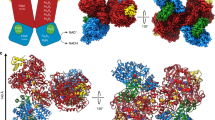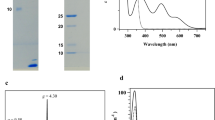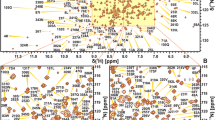Abstract
High-resolution crystal structures of Pyrococcus furiosus rubrerythrin (PfRbr) in the resting (all-ferrous) state and at time points following exposure of the crystals to hydrogen peroxide are reported. This approach was possible because of the relativity slow turnover of PfRbr at room temperature. To this end, we were able to perform time-dependent peroxide treatment of the fully reduced enzyme, under strictly anaerobic conditions, in the crystalline state. In this work we demonstrate, for the first time, that turnover of a thermophilic rubrerythrin results in approximately 2-Å movement of one iron atom in the diiron site from a histidine to a carboxylate ligand. These results confirm that, despite the domain-swapped architecture, the hyperthermophilic rubrerythrins also utilize the classic combination of iron sites together with redox-dependent iron toggling to selectively reduce hydrogen peroxide over dioxygen. In addition, we have identified previously unobserved intermediates in the reaction cycle and observed structural changes that may explain the enzyme precipitation observed for the all-iron form of PfRbr upon oxidation to the all-ferric state.






Similar content being viewed by others
References
Massey V, Strickla S, Mayhew SG, Howell LG, Engel PC, Matthews RG, Schuman M, Sullivan PA (1969) Biochem Biophys Res Commun 36:891–897
Riebe O, Fischer RJ, Wampler DA, Kurtz DM Jr, Bahl H (2009) Microbiology 155:16–24
Imlay JA (2002) Adv Microb Physiol 46:111–153
Imlay JA (2002) J Biol Inorg Chem 7:659–663
Lumppio HL, Shenvi NV, Summers AO, Voordouw G, Kurtz DM Jr (2001) J Bacteriol 183:101–108
Jenney FE Jr, Verhagen MF, Cui X, Adams MW (1999) Science 286:306–309
Coulter ED, Kurtz DM Jr (2001) Arch Biochem Biophys 394:76–86
Coulter ED, Shenvi NV, Kurtz DM Jr (1999) Biochem Biophys Res Commun 255:317–323
Sztukowska M, Bugno M, Potempa J, Travis J, Kurtz DM Jr (2002) Mol Microbiol 44:479–488
Alban PS, Popham DL, Rippere KE, Krieg NR (1998) J Appl Microbiol 85:875–882
Weinberg MV, Jenney FE Jr, Cui X, Adams MW (2004) J Bacteriol 186:7888–7895
May A, Hillmann F, Riebe O, Fischer RJ, Bahl H (2004) FEMS Microbiol Lett 238:249–254
Kurtz DM Jr (2006) J Inorg Biochem 100:679–693
deMare F, Kurtz DM, Jr, Nordlund P (1996) Nat Struct Biol 3:539–546
Jin S, Kurtz DM Jr, Liu ZJ, Rose J, Wang BC (2002) J Am Chem Soc 124:9845–9855
Iyer RB, Silaghi-Dumitrescu R, Kurtz DM Jr, Lanzilotta WN (2005) J Biol Inorg Chem 10:407–416
Jin S, Kurtz DM Jr, Liu ZJ, Rose J, Wang BC (2004) J Inorg Biochem 98:786–796
Jin S, Kurtz DM Jr, Liu ZJ, Rose J, Wang BC (2004) Biochemistry 43:3204–3213
Pierik AJ, Wolbert RB, Portier GL, Verhagen MF, Hagen WR (1993) Eur J Biochem 212:237–245
Lumppio HL, Shenvi NV, Garg RP, Summers AO, Kurtz DM Jr (1997) J Bacteriol 179:4607–4615
Bonomi F, Kurtz DM Jr, Cui X (1996) J Biol Inorg Chem 1:67–72
Dave BC, Czernuszewicz RS, Prickril BC, Kurtz DM Jr (1994) Biochemistry 33:3572–3576
Gupta N, Bonomi F, Kurtz DM Jr, Ravi N, Wang DL, Huynh BH (1995) Biochemistry 34:3310–3318
Smoukov SK, Davydov RM, Doan PE, Sturgeon B, Kung IY, Hoffman BM, Kurtz DM Jr (2003) Biochemistry 42:6201–6208
Tempel W, Liu ZJ, Schubot FD, Shah A, Weinberg MV, Jenney FE Jr, Arendall WB 3rd, Adams MW, Richardson JS, Richardson DC, Rose JP, Wang BC (2004) Proteins 57:878–882. doi:10.1002/prot.20280
Fushinobu S, Shoun H, Wakagi T (2003) Biochemistry 42:11707–11715. doi:10.1021/bi034220b
Wakagi T (2003) FEMS Microbiol Lett 222:33–37
Kurtz DM Jr, Prickril BC (1991) Biochem Biophys Res Commun 181:337–341
Kurtz DM Jr (1997) J Biol Inorg Chem 2:159–167
Rinaldo D, Philipp DM, Lippard SJ, Friesner RA (2007) J Am Chem Soc 129:3135–3147. doi:10.1021/ja0654074
Otwinowski Z, Minor QW (1997) Methods Enzymol 276:307–326
Collaborative Computational Project, Number 4 (1994) Acta Crystallogr D Biol Crystallogr 50:760–763. doi:10.1107/S0907444994003112
Murshudov GN, Vagin AA, Dodson EJ (1997) Acta Crystallogr D Biol Crystallogr 53:240–255. doi:10.1107/S0907444996012255
Brunger AT (2007) Nat Protoc 2:2728–2733. doi:10.1038/nprot.2007.406
Brunger AT, Adams PD, Clore GM, DeLano WL, Gros P, Grosse-Kunstleve RW, Jiang JS, Kuszewski J, Nilges M, Pannu NS, Read RJ, Rice LM, Simonson T, Warren GL (1998) Acta Crystallogr D Biol Crystallogr 54:905–921
Acknowledgments
This research was supported by NSF grant MCB 0835432 to W.N.L. and a grant (DE-FG05-95ER20175) to M.W.A. from the Chemical Sciences, Geosciences, and Biosciences Division, Office of Basic Energy Sciences, Office of Science, US Department of Energy.
Conflict of interest
The authors declare that they have no competing financial interests.
Author information
Authors and Affiliations
Corresponding author
Additional information
An interactive 3D complement page in Proteopedia is available at http://proteopedia.org/wiki/index.php/Journal:JBIC-11-02-00042.
Electronic supplementary material
Below is the link to the electronic supplementary material.
Rights and permissions
About this article
Cite this article
Dillard, B.D., Demick, J.M., Adams, M.W.W. et al. A cryo-crystallographic time course for peroxide reduction by rubrerythrin from Pyrococcus furiosus . J Biol Inorg Chem 16, 949–959 (2011). https://doi.org/10.1007/s00775-011-0795-6
Received:
Accepted:
Published:
Issue Date:
DOI: https://doi.org/10.1007/s00775-011-0795-6




